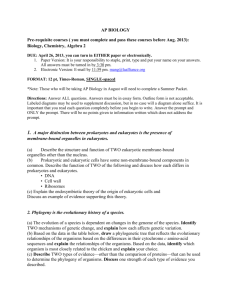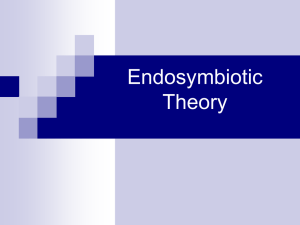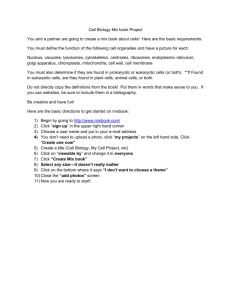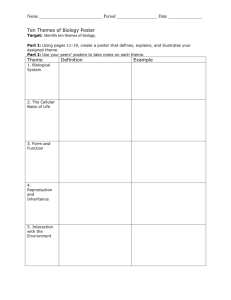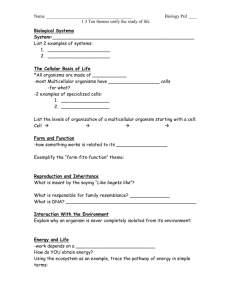Botany 305
advertisement
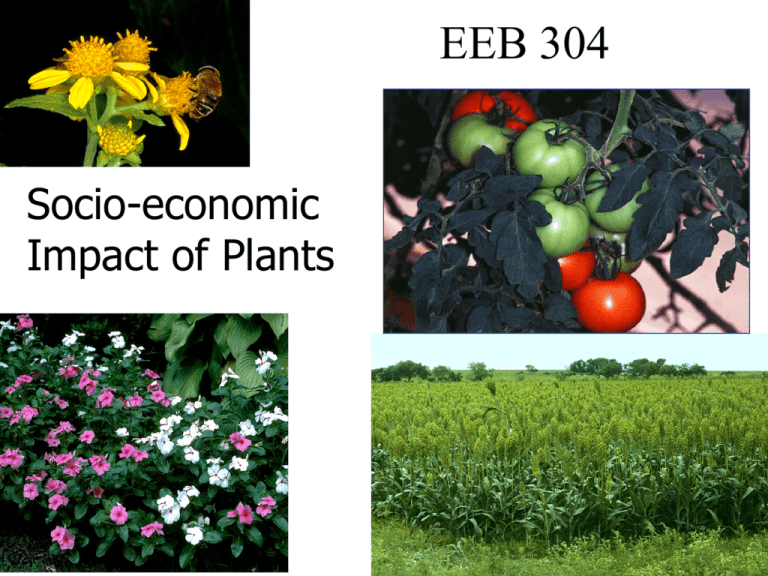
EEB 304 Socio-economic Impact of Plants Syllabus EEB 304 SOCIO-ECONOMIC IMPACT OF PLANTS Instructor: Dr. Ed Schilling SPRING SEMESTER 2011 Office: 323 Hesler, 974-2256 Class Time: Tuesday-Thursday 9:40-10:55 e-mail: eschilling@utk.edu Place: 304 Hesler Biology Building Textbook: Economic Botany, third edition. B. B. Simpson and M. C. Ogorzaly (McGraw-Hill) Note – a copy of the text has been placed on reserve at the main library How to Succeed in EEB 304 How to Succeed in EEB 304 1. Read text assignment. Read it before class. How to Succeed in EEB 304 1. Read text assignment. Read it before class. 2. Attend class. Pay attention. Take notes on lectures. Use opportunity to learn material, ask questions if unclear. How to Succeed in EEB 304 1. Read text assignment. Read it before class. 2. Attend class. Pay attention. Take notes on lectures. Use opportunity to learn material, ask questions if unclear. 3. Use powerpoint slides on class web page to review. For many lectures there will be some explanatory text with some or all of the slides – this is meant to supplement the text and lectures, not replace them. How to Succeed in EEB 304 1. Read text assignment. Read it before class. 2. Attend class. Pay attention. Take notes on lectures. Use opportunity to learn material, ask questions if unclear. 3. Use powerpoint slides on class web page to review. For many lectures there will be some explanatory text with some or all of the slides – this is meant to supplement the text and lectures, not replace them. 4. Make a list, and study, unfamiliar terms. There will probably be many – in the process of learning them, you will learn much of the course material.. Biology: The Study of Plants and Their Parasites Biology: The Study of Plants and Their Parasites World Population Growth Human Population Growth Billions Time (Years) 1 >60,000 2 123 3 33 4 14 5 13 6 11 Distribution of Population Growth World Population - Future Dynamics of World Population Growth Assignment: Go to the following web site: http://opr.princeton.edu/popclock/ Record the date and time of your visit, and write down the estimate of human world population at that moment. E-mail the results, or alternatively turn in a hard copy to class. Due 1/18. Grain Production 1950-1958 Grain Production 1950-1958 World Grain Production vs. Consumption – Last 46 Years 150 100 50 -50 -100 -150 46 43 40 37 34 31 28 25 22 19 16 13 10 7 4 1 0 World Grain Production vs. Consumption – Last 46 Years 150 100 50 46 43 40 37 34 31 28 25 22 19 16 13 10 7 4 1 0 -50 -100 -150 A primary input – China heads toward being a grain importer Economic Impact of Plants - Foods - Beverages - Fuels - Building materials - Clothing - Chemicals - Drugs - Esthetics What is a plant? Traditional View of Biology: Animals and Plants What is a plant? Traditional View of Biology: Animals and Plants Problem: Microscopic Organisms (Bacteria, Fungi, Algae) What is a plant? Traditional View of Biology: Animals and Plants Problem: Microscopic Organisms (Bacteria, Fungi, Algae) Complication: Endosymbiotic origin of organelles (Lynn Margulis) Membrane-bound structures in eukaryotic cells are derived from formerly free-living organisms that have become intimately symbiotic What is a plant? Traditional View of Biology: Animals and Plants Problem: Microscopic Organisms (Bacteria, Fungi, Algae) Complication: Endosymbiotic origin of organelles (Lynn Margulis) Membrane-bound structures in eukaryotic cells are derived from formerly free-living organisms that have become intimately symbiotic Further Information: molecular phylogenetic information 1. Confirming evidence for endosymbiotic theory What is a plant? Traditional View of Biology: Animals and Plants Problem: Microscopic Organisms (Bacteria, Fungi, Algae) Complication: Endosymbiotic origin of organelles (Lynn Margulis) Membrane-bound structures in eukaryotic cells are derived from formerly free-living organisms that have become intimately symbiotic Further Information: molecular phylogenetic information 1. Confirming evidence for endosymbiotic theory 2. Suggestion that life split early into at least 3 major lineages What is a plant? Traditional View of Biology: Animals and Plants Problem: Microscopic Organisms (Bacteria, Fungi, Algae) Complication: Endosymbiotic origin of organelles (Lynn Margulis) Membrane-bound structures in eukaryotic cells are derived from formerly free-living organisms that have become intimately symbiotic Further Information: molecular phylogenetic information 1. Confirming evidence for endosymbiotic theory 2. Suggestion that life split early into at least 3 major lineages Current Paradigm is 5 kingdom model: Monera; Protoctista; Fungi, Animalia, Plantae What is a Plant? 1. Eukaryotic 2. Chloroplasts present 3. Cell wall with cellulose 4. Autotrophic What is a Plant? 1. Eukaryotic 2. Chloroplasts present 3. Cell wall with cellulose 4. Autotrophic 5. Life Cycle with an alternation of generations What are Plants? 1. Eukaryotic 2. Chloroplasts present 3. Cell wall with cellulose 4. Autotrophic 5. Life Cycle with an alternation of generations Mystery Plant - This plant is a tropical tree. Mystery Plant - This plant is a tropical tree. - The sole source of the product originally was harvested from plants occurring in the wild. Mystery Plant - This plant is a tropical tree. - The sole source of the product originally was harvested from plants occurring in the wild - Seeds of the plant were taken (or smuggled?) out of the country in a diplomatic pouch and used to establish plantations elsewhere Mystery Plant - This plant is a tropical tree. - The sole source of the product originally was harvested from plants occurring in the wild - Seeds of the plant were taken (or smuggled?) out of the country in a diplomatic pouch and used to establish plantations elsewhere - The product became widely useful only after it was discovered accidentally how to alter its chemical and physical properties. Mystery Plant - This plant is a tropical tree. - The sole source of the product originally was harvested from plants occurring in the wild - Seeds of the plant were taken (or smuggled?) out of the country in a diplomatic pouch and used to establish plantations elsewhere - The product became widely useful only after it was discovered accidentally how to alter its chemical and physical properties. 1. What is the plant? 2. What is its native country? 3. What country was responsible for smuggling it? 4. In what century did this occur? Hevea brasiliensis “Para Rubber” Native to Brazil taken to Indonesia in 19th century “Stolen” by British Native Grown EEB 304 Lecture 2 – Plant Structures - Read Text Chapter 1
